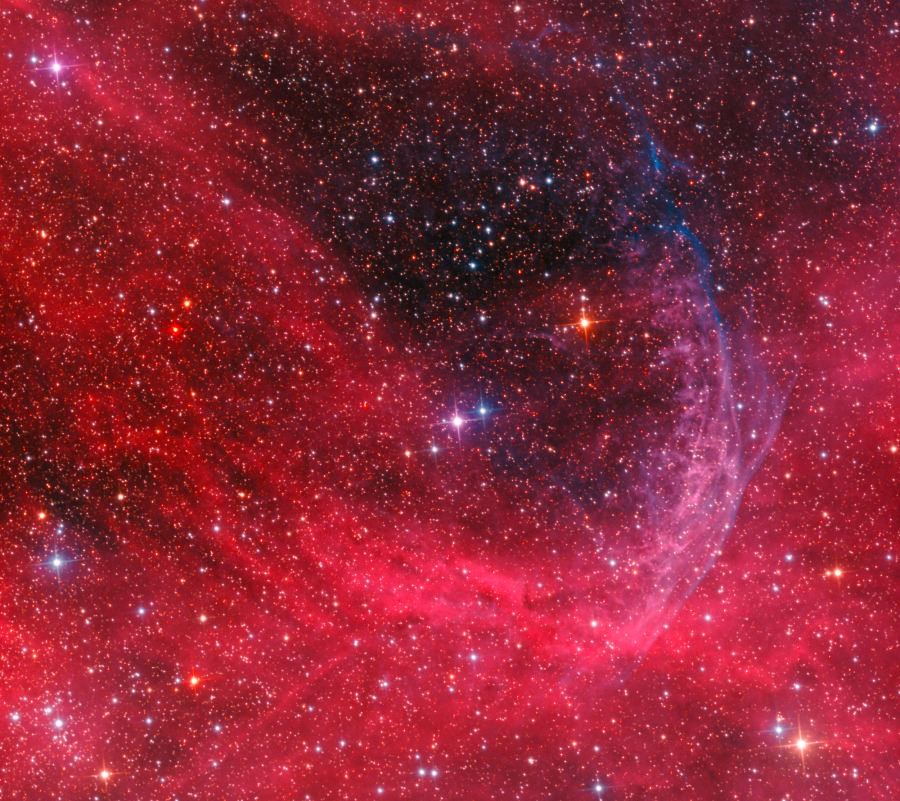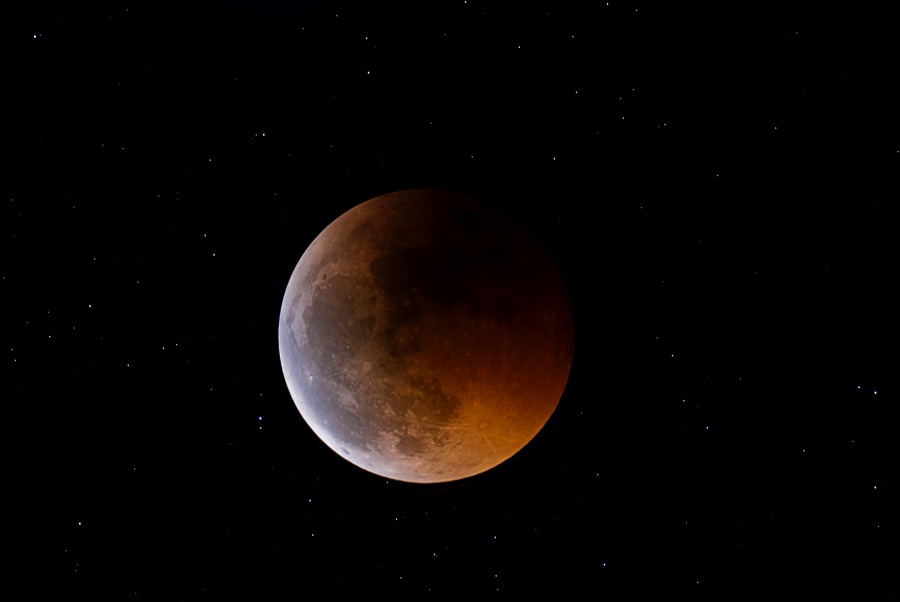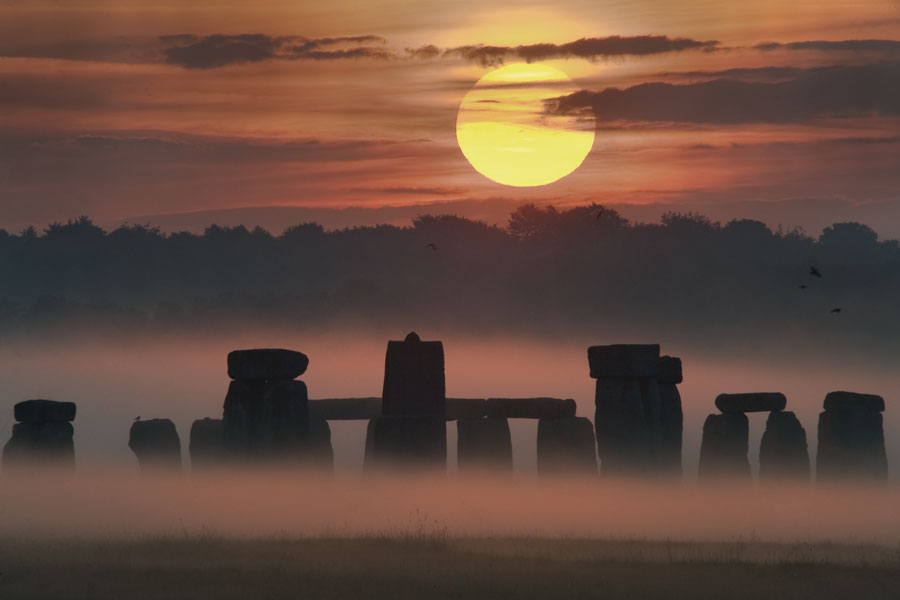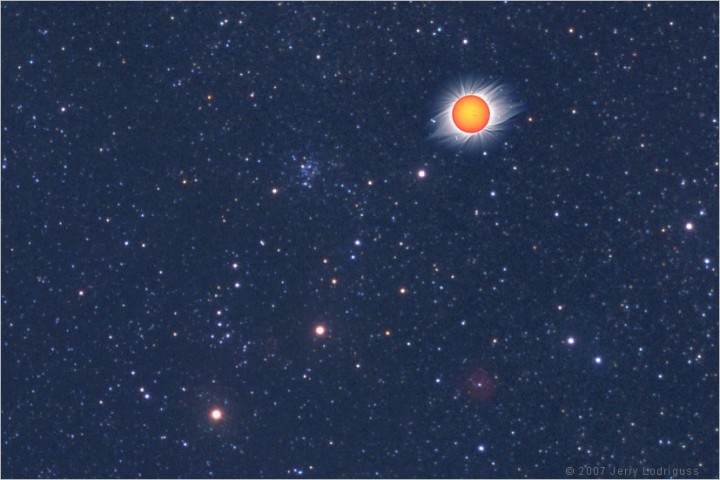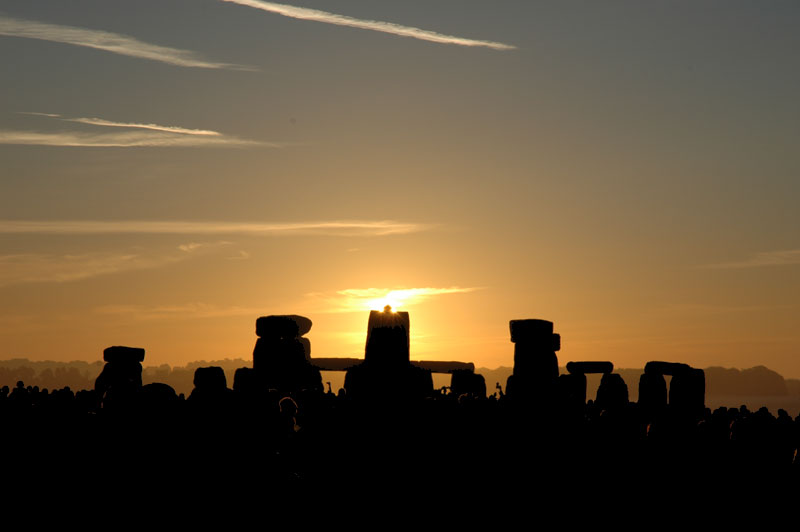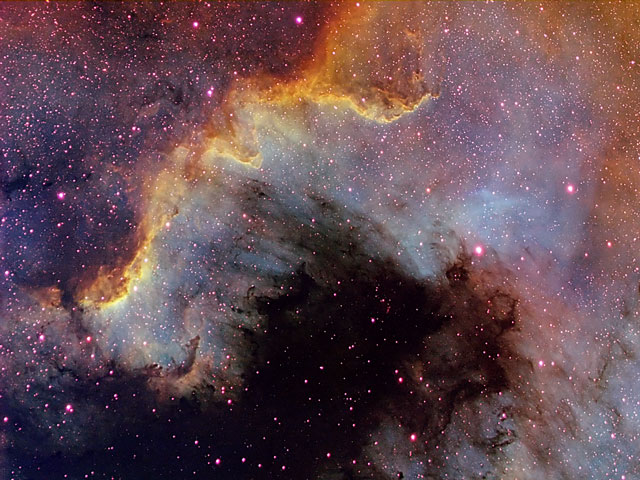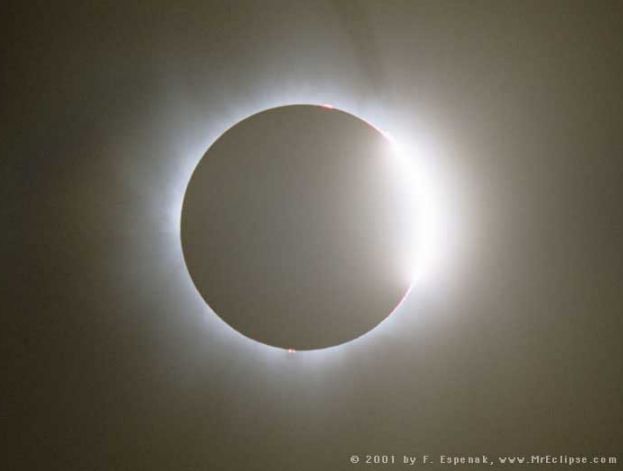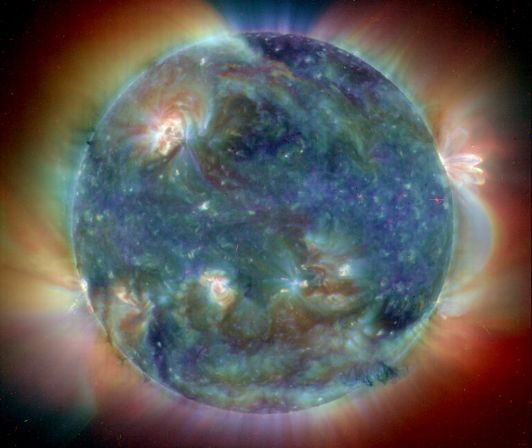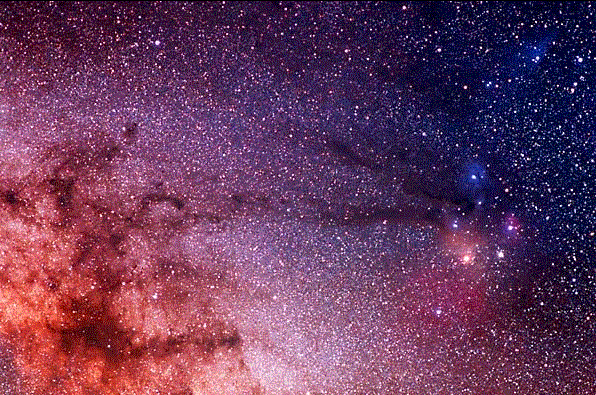| << Previous | Index | Next >> |
2015 On Saturn, the rings tell you the season. On Earth, today marks a solstice, the time when the Earth's spin axis tilts directly toward the Sun. On Earth's northern hemisphere, today is the Summer Solstice, the day of maximum daylight. Since Saturn's grand rings orbit along the planet's equator, these rings appear most prominent -- from the direction of the Sun -- when the Saturn's spin axis points toward the Sun. Conversely, when Saturn's spin axis points to the side, an equinox occurs and the edge-on rings are hard to see. In the featured montage, images of Saturn over the past 11 years have been superposed to show the giant planet passing from southern summer toward northern summer. Although Saturn will only reach its northern summer solstice in 2017 May, the image of Saturn most analogous to today's Earth solstice is the bottommost one.
2014 The Sun set on Friday the 13th as a full Honey Moon rose, captured in this well-planned time-lapse sequence. Lisbon, Portugal's Christ the King monument is in the foreground, about 6 kilometers distant from camera and telephoto lens. During the days surrounding today's solstice (June 21, 10:51 UT) the Sun follows its highest arc through northern hemisphere skies as it travels along the ecliptic plane. At night the ecliptic plane is low, and the Full Moon's path close to the ecliptic was also low, the rising Moon separating more slowly from the distant horizon. Northern moon watchers were likely to experience the mysterious Moon Illusion, the lunar orb appearing impossibly large while near the horizon. But the photo sequence shows the Moon's apparent size did not not change at all. Its light was initially scattered by the long line-of-sight through the atmosphere though, and a deeper reddened color gave way to a paler gold as the Full Moon rose into the night.
2013 Today, the solstice is at 05:04 Universal Time, the Sun reaching the northernmost declination in its yearly journey through planet Earth's sky. A June solstice marks the astronomical beginning of summer in the northern hemisphere and winter in the south. It also brings the north's longest day, the longest period between sunrise and sunset. This composite image follows the Sun's path toward the end of the June solstice day of 2012 as it approaches the western horizon in a colorful, clear sky. The scene looks north and west along the Tyrrhenian Sea coast from Santa Severa, Italy. Appearing in the well-timed sequence, the small figure of the photographer himself is illuminated against the wall of the town's medieval castle.
2012 Made with narrow and broad band filters, this colorful cosmic snap shot covers a field of view about the size of the full Moon within the boundaries of the constellation Cygnus. It highlights the bright edge of a ring-like nebula traced by the glow of ionized hydrogen and oxygen gas. Embedded in the region's interstellar clouds of gas and dust, the complex, glowing arcs are sections of bubbles or shells of material swept up by the wind from Wolf-Rayet star WR 134, brightest star near the center of the frame. Distance estimates put WR 134 about 6,000 light-years away, making the frame over 50 light-years across. Shedding their outer envelopes in powerful stellar winds, massive Wolf-Rayet stars have burned through their nuclear fuel at a prodigious rate and end this final phase of massive star evolution in a spectacular supernova explosion. The stellar winds and final supernovae enrich the interstellar material with heavy elements to be incorporated in future generations of stars.
2011 A celestial prelude to today's solstice, the June 15 total lunar eclipse was one of the longest in recent years. It was also one of the darkest, but not completely dark. Even during totality, a somber, red lunar disk could be seen in the starry night sky, reflecting reddened light falling on to its surface. Seen from a lunar perspective, the ruddy illumination is from all the sunsets and sunrises around the edges of a silhouetted Earth. In this sharp portrait of the eclipsed Moon from Granada, Spain, the Moon's edge reflects a bluish tinge as well as it emerges from Earth's umbral shadow. The bluer light is still filtered through Earth's atmosphere, but originates in rays of sunlight passing through layers high in the upper stratosphere. That light is colored by ozone that absorbs red light and transmits bluer hues.
2010 Today the Sun reaches its northernmost point in planet Earth's sky. Called a solstice, the date traditionally marks a change of seasons -- from spring to summer in Earth's Northern Hemisphere and from fall to winter in Earth's Southern Hemisphere. The above image was taken during the week of the 2008 summer solstice at Stonehenge in United Kingdom, and captures a picturesque sunrise involving fog, trees, clouds, stones placed about 4,500 years ago, and a 5 billion year old large glowing orb. Even given the precession of the Earth's rotational axis over the millennia, the Sun continues to rise over Stonehenge in an astronomically significant way.
2009 Today, the sun will stay in the sky longer than any other day of the year, as seen from the northern hemisphere of Earth. Named the Summer Solstice, today's maximum daylight is indicative of the high amount of sunlight this time of year that is primarily responsible for the heat of the summer season. At the north pole and for all places above the arctic circle, there will be no night -- the entire day today will be lit by sunlight. The situation is reversed in Earth's southern hemisphere, where today has the least sunlight of any day. Today's solstice is commemorated above by a well-planned picture of our five billion year old Sun rising behind the 2,500 year old Parthenon in Greece. Trees and birds occupy the foreground, while a modern crane is shown restoring parts of this historic symbol of a cultural civilization.
2008 Compare these two close-up pictures taken on sol 20 (left) and sol 24 of a trench dug in the Martian surface by NASA's Phoenix Lander. Those sols of the Phoenix Mission (a sol is a Martian day), correspond to June 15 and 18 on planet Earth. Light-colored, dice-sized chunks, visible in the lower left shadow region of the trench in the sol 20 image have vanished by sol 24 -- a strong indication that the chunks were ice uncovered by digging the shallow trench. The vanishing act likely demonstrates the sublimation of ice in the trench, a process similar to evaporation, in which the ice went directly from solid to gas after it was exposed to sunlight and the thin, dry Martian atmosphere.
2007 If you could turn off the atmosphere's ability to scatter overwhelming sunlight, today's daytime sky might look something like this ... with the Sun surrounded by the stars of the constellations Taurus and Gemini. Of course, today is the Solstice. Traveling along the ecliptic plane, the Sun is at its northernmost position in planet Earth's sky, marking the astronomical beginning of summer in the north. Accurate for the exact time of today's Solstice, this composite image also shows the Sun at the proper scale (about the angular size of the Full Moon). Open star cluster M35 is to the Sun's left, and the other two bright stars in view are Mu and Eta Geminorum. Digitally superimposed on a nighttime image of the stars, the Sun itself is a composite of a picture taken through a solar filter and a series of images of the solar corona recorded during the solar eclipse of February 26, 1998 by Andreas Gada.
2006 Today the Sun reaches its northernmost point in the planet Earth's sky. Called a solstice, the date traditionally marks a change of seasons -- from spring to summer in Earth's Northern Hemisphere and from fall to winter in Earth's Southern Hemisphere. Pictured above is the 2005 Summer Solstice celebration at Stonehenge in England. The event was rare because Stonehenge was not always open to the public, and because recent summer solstices there had been annoyingly cloudy. In 2005, however, thousands of people gathered at sunrise to see the sun rise through the 4,000 year old solar monument. Even given the precession of the Earth's rotational axis over the millennia, the Sun continues to rise over Stonehenge in an astronomically significant way. In fact, the photographer was able to find a good spot where the rising Sun appeared over one of Stonehenge's massive standing stones
2005 The North America Nebula in the sky can do what North Americans on Earth cannot -- form stars. Specifically, in analogy to the Earth-confined continent, the bright part that appears as Central America and Mexico is actually a hot bed of gas, dust, and newly formed stars known as the Cygnus Wall. The above image in representative colors shows the star forming wall lit and eroded by bright young stars, and partly hidden by the dark dust they have created. The part of the North America nebula (NGC 7000) shown spans about 15 light years and lies about 1,500 light years away toward the constellation of Cygnus.
2004 An analemma is that figure-8 curve that you get when you mark the position of the Sun at the same time each day throughout planet Earth's year. Above, 44 separate exposures (plus one foreground exposure) were recorded on a single piece of film to illustrate the regular solar motion -- a Herculean task performed during the calendar year 2003. Appropriately, in the foreground are the ruins at Ancient Nemea where the hero of Greek Mythology pursued the first of his twelve labours. Solstices, like the one that occurred at 0057 UT on June 21, correspond to the top and bottom of the figure-8 or the northern and southernmost excursions of the Sun in the sky. The tilt of planet Earth's axis and the variation in speed as it moves around its orbit combine to produce the graceful analemma curve.
2003 The Earth's northern hemisphere is outlined as a sunlit crescent in this dramatic view from orbit, recorded near local midnight by the Geostationary Operational Environmental Satellite (GOES-8) on June 22, 1996. That date was two days after the Solstice, by astronomical reckoning, the first day of summer in the north and winter in the southern hemisphere. Today's scheduled geocentric astronomical event is again the northern hemisphere's summer Solstice, with the Sun reaching its northernmost declination at 19 hours 10 minutes Universal Time. That makes today also the longest day of the year in the north, with the arctic regions near the top of the picture experiencing 24 hours of daylight. Looking south along the Earth's limb, atmospheric scattering of sunlight causes the limb to be visible beyond areas directly illuminated by the sun.
2002 Today's scheduled geocentric astronomical event is the Solstice, with the Sun reaching its northernmost declination at 13 hours 24 minutes Universal Time. For denizens of planet Earth this Solstice marks the beginning of Summer in the northern hemisphere and Winter in the south. Of course, the tilt of the Earth's axis of rotation (and not a change in the Earth-Sun distance) is mainly responsible for the changing seasons and the Sun's yearly north-south motion through the sky. Following the rising and setting points of the Sun along the horizon is one way to track the Sun's progress along its seasonal cycle. Tall grasses and tinted clouds frame this dramatic view of the setting Sun approaching the northern limit of this year's seasonal journey as seen near Raffingora, Zimbabwe.
2001 Today, earthbound skygazers can celebrate a solstice, a new Moon, the closest approach of planet Mars since 1988 ... oh yes, and a total eclipse of the Sun, the first total solar eclipse of the third millennium. Of course for some, today's most spectacular celestial views will be of the eclipsed Sun from along the path of totality as the new Moon's shadow tracks across southern Africa and Madagascar. This picture from the August 1999 total solar eclipse captures the shimmering solar corona just as that eclipse's total phase ended, as seen from eastern Turkey. The first rays of bright sunlight shinning through edge-on lunar mountains and valleys create the fleeting appearance of glistening diamonds set in a ring around the Moon's silhouette. Do you want to see today's solar eclipse? Eclipse expeditions are offering live webcasts.
2000 Season's greetings! At 01:48 Universal Time on June 21 the Sun reaches its northernmost point in planet Earth's sky marking a season change and the first solstice of the year 2000. In celebration, consider this delightfully detailed, brightly colored image of the active Sun. From the EIT instrument onboard the space-based SOHO observatory, the tantalizing picture is a false-color composite of three images all made in extreme ultraviolet light. Each individual image highlights a different temperature regime in the upper solar atmosphere and was assigned a specific color; red at 2 million, green at 1.5 million, and blue at 1 million degrees C. The combined image shows bright active regions strewn across the solar disk, which would otherwise appear as dark groups of sunspots in visible light images, along with some magnificent plasma loops and an immense prominence at the righthand solar limb.
1999 The center of our Galaxy is a busy place. In visible light, much of the Galactic Center is obscured by opaque dust. In infrared light, however, dust glows more and obscures less, allowing nearly one million stars to be recorded in the above photograph. The Galactic Center itself appears on the right and is located about 30,000 light years away towards the constellation of Sagittarius. The Galactic Plane of our Milky Way Galaxy, the plane in which the Sun orbits, is identifiable by the dark diagonal dust lane. The absorbing dust grains are created in the atmospheres of cool red-giant stars and grow in molecular clouds. The region directly surrounding the Galactic Center glows brightly in radio and high-energy radiation, and is thought to house a large black hole.
1998 No person in history has had greater impact in determining the extent of our universe than Edwin Hubble. From proving that other galaxies existed to proving that galaxies move apart from one another, Hubble's work defined our place in the cosmos. Hubble lived from 1889 to 1953 and is shown above posing with the 48-inch telescope on Palomar Mountain and his famous pipe. In memory of his great work, the Orbiting Space Telescope was named after him. The rate of the universe's expansion is now parameterized by a quantity known as Hubble's constant. A modern debate on the value of Hubble's constant took place in 1996.
1997 The dark nebula predominant at the lower left of the above photograph is known as the Pipe Nebula. The dark clouds, suggestively shaped like smoke rising from a pipe, are caused by absorption of background starlight by dust. These dust clouds can be traced all the way to the Rho Ophiuchi nebular clouds on the right. The brightest star in the field is Antares. Many types of nebula are highlighted here: the red are emission nebula, the blue are reflection nebula, and the dark are absorption nebula. This picture has been digitally enhanced.
1996 Pictured above is one of the world's premiere radio astronomical observatories: The Very Large Array (VLA). Each antenna dish is as big as a house (25 meters across) and mounted on railroad tracks. The VLA consists of 27 dishes - together capable of spanning the size of a city (35 kilometers). The VLA is the most sensitive radio telescope ever, and, through interferometry, can resolve a golf ball-sized radio source 150 kilometers away (0.04 arcsec). The VLA is continually making new discoveries, including determining the composition of galaxies, passing comets, quasars, HII regions, and clusters of galaxies. The VLA is also used to receive the weak radio signals broadcast from interplanetary spacecraft. The VLA is located in New Mexico, USA. A significant upgrade of VLA's capabilities is planned.
1995 In 1987 a star in one of the Milky Way's satellite galaxies exploded. In 1994 the Hubble Space Telescope, in orbit around the earth, took a very detailed picture of the remnants of this explosion. This picture, above, showed unusual and unexpected rings, and astronomers are not sure how they formed.
| << Previous | Index | Next >> |



